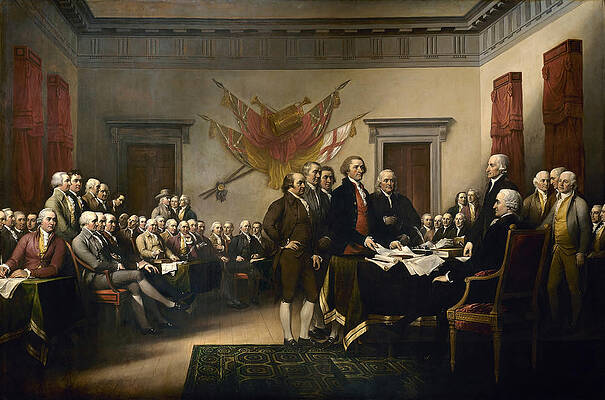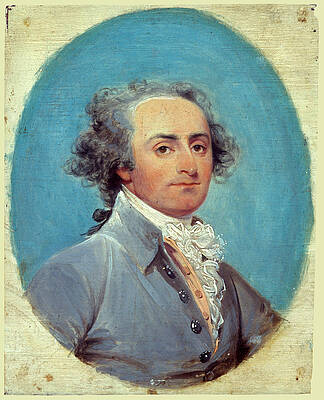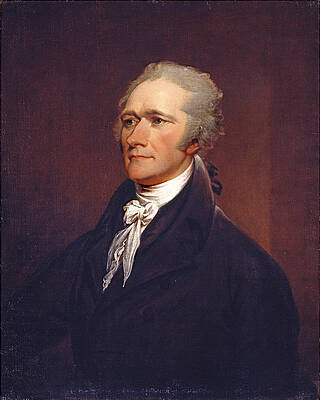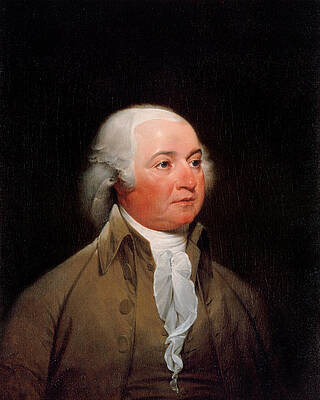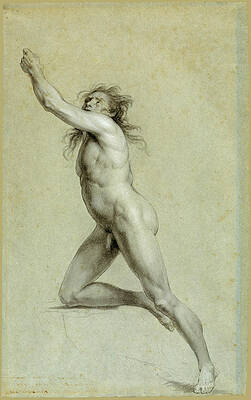John Trumbull
Paintings
Declaration of Independence
George Washington before the Battle of Trenton
George Washington and William Lee
Giuseppe Ceracchi
Thomas Jefferson
Surrender of Lord Cornwallis
John Adams
Alexander Hamilton
John Adams
Patrick Tracy
Washington at Verplank's Point
General George Washington Resigning His Commission
Surrender of General Burgoyne
The Sortie Made by the Garrison of Gilbraltar
Alexander Hamilton 2
Study from Life. Nude Male


The Declaration of Independence, detail

John Lawrence

GENERAL PHILIP SCHUYLER
Fine Art Prints | Greeting Cards | iPhone Cases | Tote Bags | Clothing | Lifestyle | Beach ...
John Trumbull (June 6, 1756 – November 10, 1843) was an American artist during the period of the American Revolutionary War and was notable for his historical paintings. His Declaration of Independence (1817) was used on the reverse of the two-dollar bill.
Early years
Trumbull was born in Lebanon, Connecticut, in 1756, to Jonathan Trumbull and his wife Faith (née Robinson) Trumbull. His father served as Governor of Connecticut from 1769 to 1784. Both sides of his family were descended from early Puritan settlers in the state.
The young Trumbull entered the 1771 junior class at Harvard College at age fifteen and graduated in 1773. Due to a childhood accident, Trumbull lost use of one eye, which may have influenced his detailed painting style.[1]
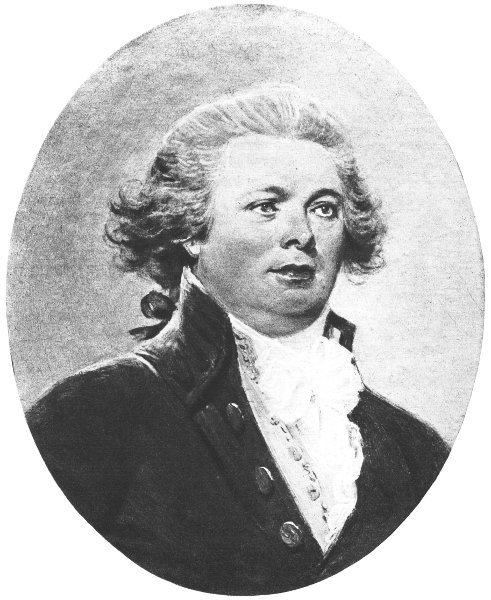
John Lawrence, John Trumbull.
Actual size 3-3/4 inches high.
IN THE POSSESSION OF
THE NEW YORK HISTORICAL SOCIETY
Revolutionary War
Trumbull's self-portrait painted in 1777.
As a soldier in the American Revolutionary War, Trumbull rendered a particular service at Boston by sketching plans of the British works. He witnessed the Battle of Bunker Hill. He was appointed second personal aide to General George Washington, and in June 1776, deputy adjutant-general to General Horatio Gates. He resigned from the army in 1777 after a dispute over the dating of his officer commission.
In 1780 he traveled to London, where he studied under Benjamin West. At West's suggestion, Trumbull painted small pictures of the War of Independence and miniature portraits. He painted about 250 in his lifetime.
On September 23, 1780, British agent Major John André was captured by Continental troops in North America; he was hanged as a spy on October 2, 1780. After news reached Great Britain, outrage flared and Trumbull was arrested, as having been an officer in the Continental Army of similar rank to André. He was imprisoned for seven months in London's Tothill Fields Bridewell.
Postwar years
The Death of Montgomery in the Attack on Quebec (1787)
After being released, Trumbull returned to the United States. In 1784, following the British recognition of the United States' independence, he returned to London for painting study under West. While working in his studio, Trumbull painted Battle of Bunker Hill and Death of General Montgomery at Quebec. Both works are now in the Yale University Art Gallery.
In 1785 Trumbull went to Paris, where he made portrait sketches of French officers for the Surrender of Lord Cornwallis. With the assistance of Thomas Jefferson, serving there as the US minister, Trumbull began Declaration of Independence. While in Paris, Trumbull is credited with having introduced Jefferson to the Italian painter Maria Cosway; they became lifelong intimate friends. Trumbull's painting became widely known due to a later engraving of it by Asher Brown Durand, which was reproduced.
This Independence painting was purchased by the United States Congress, along with his Surrender of General Burgoyne, Surrender of Lord Cornwallis, and Washington Resigning his Commission, all related to the Revolution. All now hang in rotunda of the United States Capitol. Congress reportedly authorized only funds sufficient to purchase these four paintings.
Trumbull completed other paintings related to the Revolution: Death of General Warren at Bunker's Hill (one version is held by the Boston Museum of Fine Arts); Death of General Montgomery at Quebec; Capture of Hessians at Battle of Trenton; Death of General Mercer at Battle of Princeton. Trumbull's The Sortie Made by the Garrison of Gibraltar, 1789, owned by the Boston Athenaeum, is now held by the Metropolitan Museum of Art in New York City.
Middle years
George Washington Before the Battle of Trenton, oil on canvas, c. 1792. Yale University Art Gallery
In 1831 Trumbull sold a series of 28 paintings and 60 miniature portraits to Yale University for an annuity of $1,000. This is by far the largest single collection of his works. The collection was originally housed in a neoclassical art gallery designed by Trumbull on Yale's Old Campus, along with portraits by other artists.[2]
His portraits include full lengths of General Washington (1790) and George Clinton (1791), in New York City Hall. New York also bought his full-length paintings of Alexander Hamilton (1805, the source of the face on the $10 bill[3]) and John Jay. In 1791 he was elected a Fellow of the American Academy of Arts and Sciences.[4]
He painted portraits of John Adams (1797), Jonathan Trumbull, and Rufus King (1800); Timothy Dwight and Stephen Van Rensselaer (both at Yale), Alexander Hamilton (one in the Metropolitan Museum of Art and one in the Boston Museum of Fine Arts, both taken from Ceracchi's bust), a self-portrait (1833), a full-length of Washington, held at Charleston, South Carolina; a full length of Washington in uniform (1792), (now at Yale); and portraits of President and Mrs. Washington (1794), in the National Museum of American History.
Trumbull was painted by Gilbert Stuart and many others.
In 1794 Trumbull acted as secretary to John Jay in London during the negotiation of the treaty with Great Britain, which largely settled the boundary with Canada. In 1796 he was appointed by the commissioners sent by the two countries as the fifth member of a commission charged with carrying out the seventh article of the Jay Treaty, which mediated claims by American and British merchants and the opposing government stemming from actions which occurred during the war. Shortly after the end of Trumbull's service on this commission he traveled to Stuttgart to pick up the completed engraving of the Battle of Bunker's Hill. On the return trip he passed through Paris and carried the first dispatch from the XYZ Affair out of France.[5]
Later years
Portrait miniature of John Trumbull executed in 1840 by Ann Hall presently in a private collection in Darien, Connecticut
Trumbull was appointed president of the American Academy of the Fine Arts in New York City, serving for twenty years, from 1816 to 1836.[6] Emphasizing classical traditions, Trumbull did not get along with the students. At the same time, his painting skills declined. In 1825 many of the students withdrew, founding the National Academy of Design.[7] Unable to accommodate to changing tastes, the American Academy later closed in 1839 after a second fire destroyed its collections.
Trumbull wrote his autobiography, which he published in 1841. He died in New York City at the age of 87 on November 10, 1843.
Legacy and honors
Reverse of U.S. two-dollar bill
John Trumbull's Declaration of Independence.
John Trumbull commemorative postage stamp, 1968.
Trumbull was originally interred (along with his wife) beneath the Art Gallery at Yale University, which he had designed. In 1867, the collection of his works were moved to the newly built Street Hall. His and his wife's remains were reinterred on those grounds.[8] The Trumbull Gallery was later razed.
1965, the John Trumbull Birthplace in Lebanon, Connecticut, was declared a National Historic Landmark.
1968, a John Trumbull commemorative postage stamp was printed.
Paintings
The Death of General Warren at the Battle of Bunker Hill
The Death of General Montgomery in the Attack on Quebec
Declaration of Independence
Capture of the Hessians at the Battle of Trenton
Death of General Mercer at the Battle of Princeton
The Surrender of General Burgoyne at Saratoga
The Surrender of Cornwallis at Yorktown
Washington Resigning his Commission
Portraits of George Washington and John Adams
The Death of Aemilius Paullus at the Battle of Cannae
The Sortie Made by the Garrison of Gibraltar
Self-portrait
Portrait of Josiah Bartlett
Jonathan Trumbull, Jr. (1740-1809) with Mrs. Trumbull (Eunice Backus) (1749-1826) and Faith Trumbull (1769-1846)
See also
Trumbull, Connecticut
Trumbull County, Ohio
Notes
"Gentleman John Trumbull". Time Magazine. 1956-10-29. Retrieved 2008-02-17.
Yale Art Gallery: Trumbull
Dunlap, David W. (2006-12-06). "In New York, Taking Years Off the Old, Famous Faces Adorning City Hall". The New York Times. Retrieved 2007-01-07.
"Book of Members, 1780–2010: Chapter T". American Academy of Arts and Sciences. Retrieved August 7, 2014.
Jaffe, Irma (1975). John Trumbull: Patriot-Artist of the American Revolution. New York Graphic Society. pp. 177–182.
Jaffe, Irma (1975). John Trumbull: Patriot-Artist of the American Revolution. New York Graphic Society. pp. 264–275.
Dunlap, William (1918). A History of the Rise and Progress of the Arts of Design in the United States (Vol 3). C. E. Goodspeed & Co. pp. 52–57. Retrieved 2008-02-17.
Trumbull Gallery at Yale
References
Trumbull, John (1841). Autobiography. New York. ISBN 0-917678-38-9.
Weir, J.F. (1901). John Trumbull, A Brief Sketch of His Life, to which is added a Catalogue of his Works. New York: C. Scribner's sons. Retrieved 2008-02-16.
Durand, John (1881). "John Trumbull". American Art Review (Boston) ii (2): 181–191.
Murray, P. & L. (1996). Dictionary of Art and Artists. Penguin Books. ISBN 0-14-051300-0.
Cooper, Helen A. (1983). John Trumbull: The Hand and Spirit of a Painter. New Haven, CT: Yale University Press. ISBN 978-0894670244.
Jaffe, Irma B. (1975). John Trumbull, Patriot-Artist of the American Revolution. Boston, MA: New York Graphic Society. ISBN 9780821204597.
Chisholm, Hugh, ed. (1911). "Trumbull, John (artist)". Encyclopædia Britannica (11th ed.). Cambridge University Press.
----
Fine Art Prints | Greeting Cards | Phone Cases | Lifestyle | Face Masks | Men's , Women' Apparel | Home Decor | jigsaw puzzles | Notebooks | Tapestries | ...
----
Artist
A - B - C - D - E - F - G - H - I - J - K - L - M -
N - O - P - Q - R - S - T - U - V - W - X - Y - Z
Retrieved from "http://en.wikipedia.org/"
All text is available under the terms of the GNU Free Documentation License


